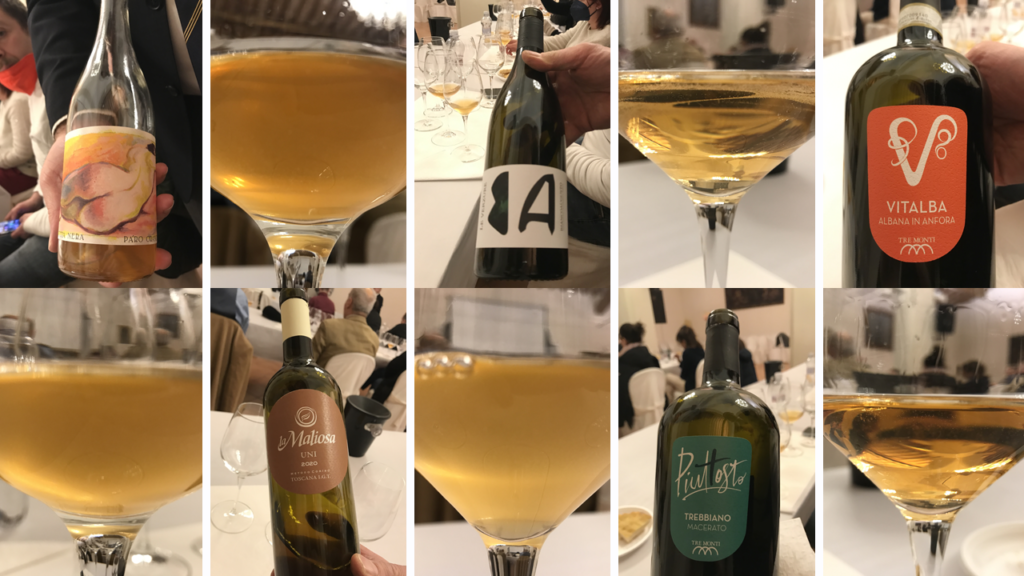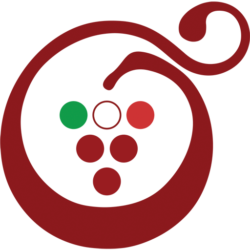
Siena (Italy), January 12th 2022 – The Italian Sommelier Association (AIS) organized for its member sommeliers a skin-contact white wine masterclass.
Skin-contact (orange) wines masterclass.
The skin contact winemaking process results in an orange/peach/tangerine hue which leads people to call it “orange wine”. However, most winemakers prefer to call the wine “amber” or “skin-contact” wine since it is not made with oranges nor tastes like oranges.
What is skin-contact wine?
It is a white wine made by leaving the grape skins in contact with the juice, creating a deep orange-hued finished product with a bigger structure.
White wine vinification is a process in which white grapes are picked then the skins are removed leaving only the juice undergoing alcoholic fermentation.
Red wine vinification means red grapes are picked and the skins remain in the entire fermentation process. Besides other components, the deeper colour comes from skin maceration.
So, in short, skin-contact wine is made by using white grapes through a red winemaking process.
Are skin-contact wines natural?
Skin contact is a technique above all. Most skin-contact wines are low intervention wines, often spontaneous fermentation, no sulphates added, the resulting wines are not fined nor filtered. But it doesn’t dictate that a winemaker cannot use modern oenology techniques, such as selected yeast and temperature-controlled vessels.
Where do skin-contact wines come from?
It is one of the oldest types of wine in the world, it has been around for over 5,000 years. Georgia is where the technique is believed to have originated. The traditional method of winemaking used in the region is to let indigenous white grapes ferment on their skins undisturbed in egg-shaped clay jars (called qvevri) buried in the earth for as long as necessary.
In the early 1990s, inspired by Georgian winemaking techniques and natural viticulture, a pair of cult winemakers from the northeast of Italy, Radikon and Gravner, began to produce skin-contact wines and so brought it to distinction and inspired a new era of experimentation.
How to arrange skin-contact wines within wine lists?
If you are a sommelier, you might wonder if place them in the “White wines category” or “Rosé wine category”. I would add a “Skin-contact white wine” category.
Even if they are made from white grape varietals, the colour is much darker and tannin presence might confuse some customers. Although the colour is very close to some pale pink rosé wines, which undergo only several hours of skin maceration, they are not made from red grapes varietals.

Wines tasted list:
- Pa’Ro 2020 IGT Toscana Bianco, Buccia Nera Loc. Campriano (Arezzo)
- Uni 2020 IGT Toscana Bianco, Fattoria La Maliosa di Saturnia (Grosseto)
- Biancoaugusto 2018 IGT Toscana Bianco, Le Verzure di Murlo (Siena)
- Biancoaugusto 2020 IGT Toscana Bianco, Le Verzure di Murlo (Siena)
- Piuttosto 2020 Trebbiano Rubicone IGT Emilia Bianco, Tremonti di Imola (Bologna)
- Vitalba 2020 Romagna Albana DOCG, Tremonti di Imola (Bologna)
Buccia Nera
Mr Sandro is the oenologist of Buccia Nera winery, run by the 5th generation. It is an organic farm certified since 2002 with around 45ha of vineyards in different parcels, from 400 m to 600 m of altitude. The main focus is on Sangiovese production and its resulting Chianti.
Pa’Ro is made of Trebbiano and Grechetto grapes from very old vines. The winemaker objective is to have a skin-contact wine but doesn’t want to push the extraction to the extreme, thus skin maceration occurs for about 35 days in a stainless tank at 17°C temperature controlled.
Pa’Ro 2020 IGT Toscana Bianco, Buccia Nera Loc. Campriano (Arezzo)
- Amber colour, shiny nose with herbaceous hints. Long tactile sensation on the palate. Fresh and pleasant.
Fattoria La Maliosa
Ms Caterina is Fattoria La Maliosa rappresentative. La Maliosa was born in 2009, but the vineyards are thee from 1960. Biodiversity and sustainability are the focus. The farm includes a total of 165 ha, of which 6 ha are occupied by vineyards, almost 4000 olive trees. Their wines have a carbon footprint certified and an overall carbon positive balance. They produce 5 wines, 2 white and 3 red, all organic certified. Interesting to note that they grow Cannonau Grigio grapes, similar to French Grenache and with nothing to do with Sardinian Cannonau.
Uni is made of 100% Procanico, which belong to the large family of Trebbiano Toscano grapes but in reality, Procanico and Trebbiano Toscano are quite different. Uni is the Etruscan name of the queen of the goddess. Around 4 weeks of skin maceration, spontaneous fermentation, no yeast added, no fining, no filtering.
Uni 2020 IGT Toscana Bianco, Fattoria La Maliosa di Saturnia (Grosseto)
- Intense orange colour. Aromatic herbs on the nose with slight sweet note. Soft tannins, precise and central. Clean and harmonious wine.
Le Verzure di Murlo
Mr Luigi is the winemaker at Le Verzure. The oenologist is Adriano Zago, a famous name in the biodynamic field. Young winery (2003), 4 ha of Sangiovese, 2 ha of Trebbiano and Malvasia, 5 ha of olives trees, all organic, completely surrounded by forest. They make only 4 wines, 1 white, 2 red and 1 red in amphora.
Biancoaugusto is made of a blend of Trebbiano (around 70%) and Malvasia (around 30%). Spontaneous fermentation. About 6 months skin maceration.
Biancoaugusto 2018 IGT Toscana Bianco, Le Verzure di Murlo (Siena)
- Orange with golden highlights. Slightly aromatic on the nose (thanks to Malvasia contribution). Evident tannins, but soft and elegant with good structure.
Biancoaugusto 2020 IGT Toscana Bianco, Le Verzure di Murlo (Siena)
- Aromaticity from Malvasia is less evident. Freshness at first, then soft tannins will wrap all palate.
Tremonti di Imola
Tremonti winery, located in Romagna, includes 55 ha split into 2 estates (Imola and Forli). Its main focus is on the traditional Albana and Sangiovese grapes, accompanied by interesting experimentation, such as the first 100% Chardonnay and 100% Sauvignon Blanc ever produced in Romagna, wine without sulphites added, skin-contact wines. It is organic certified since 2014.
Piuttosto 2020 Trebbiano Rubicone IGT Emilia Bianco, Tremonti di Imola (Bologna)
This is a modern interpretation of the skin-contact method, 100% Trebbiano Romagnolo, about 20 days skin maceration in a cement vessel.
- Light golden colour, but limpid. Gentle on the nose. Slight carbonic residual, fresh and very soft tannins. High drinkability. It is shorter compare to the previous wines, we are in the “normal” white wine real, simply longer maceration but oxidation and tannins are limited.
Vitalba 2020 Romagna Albana DOCG, Tremonti di Imola (Bologna)
100% Albana grape, about 3 months skin maceration in clay amphora, 14.5% alcohol, often awarded over 90-point by Wine Spectator and Wine Enthusiast.
- Intense deep golden colour. Ripe fruits and spirit infused fruits on the nose: the alcoholic component is obvious. Significant tannic sensation, but smooth, very big structure, long and persistent.
Watch the Youtube video

